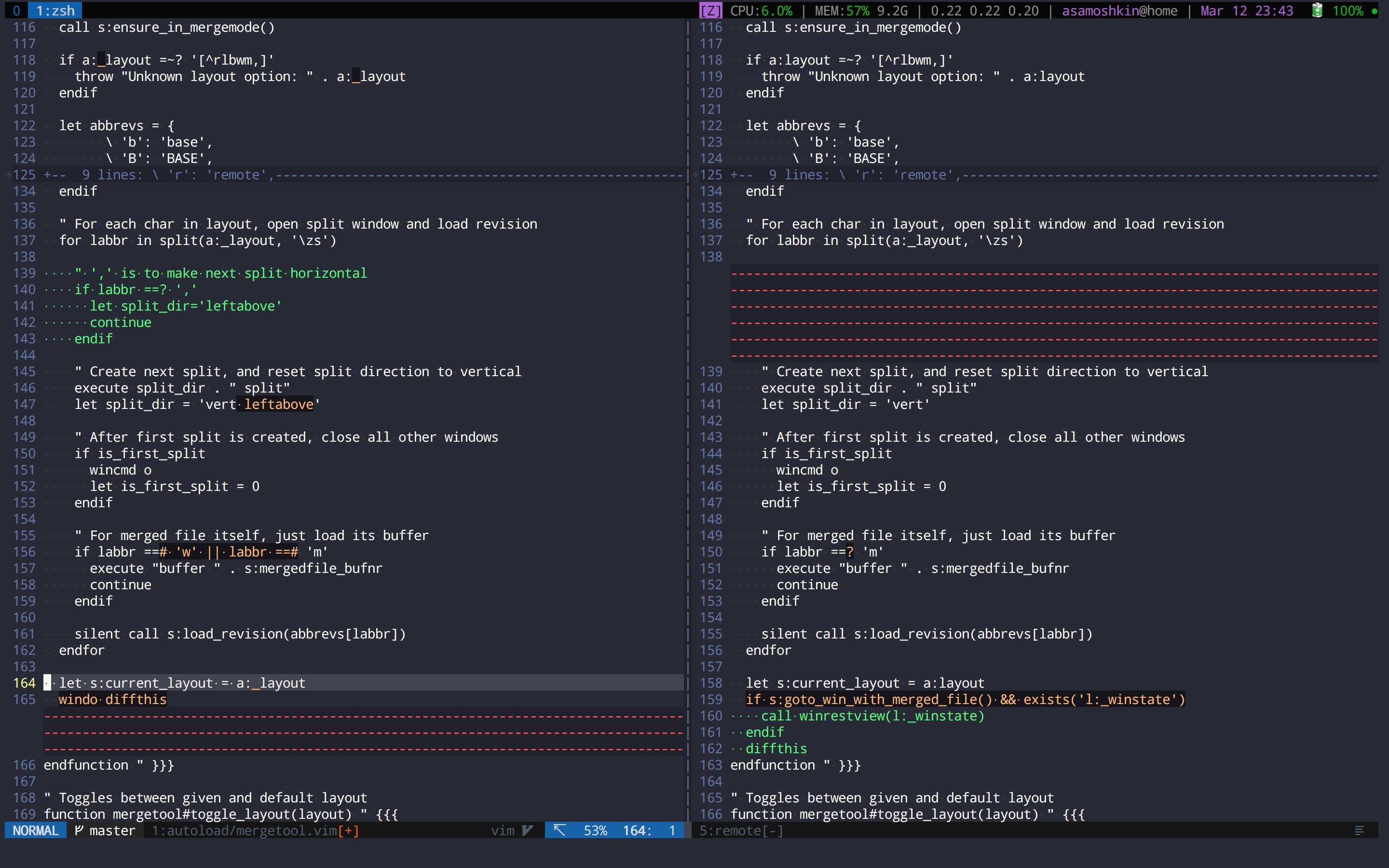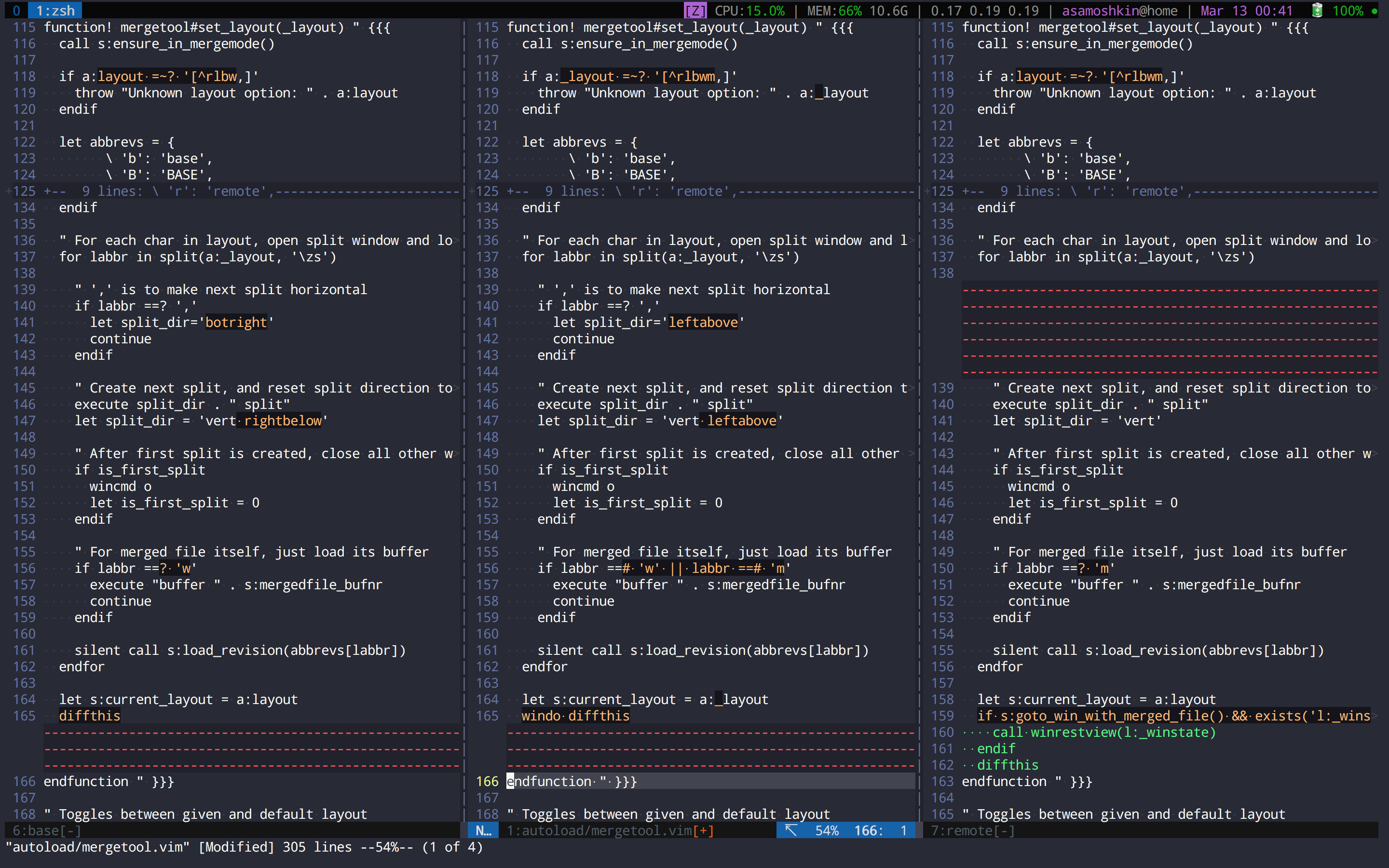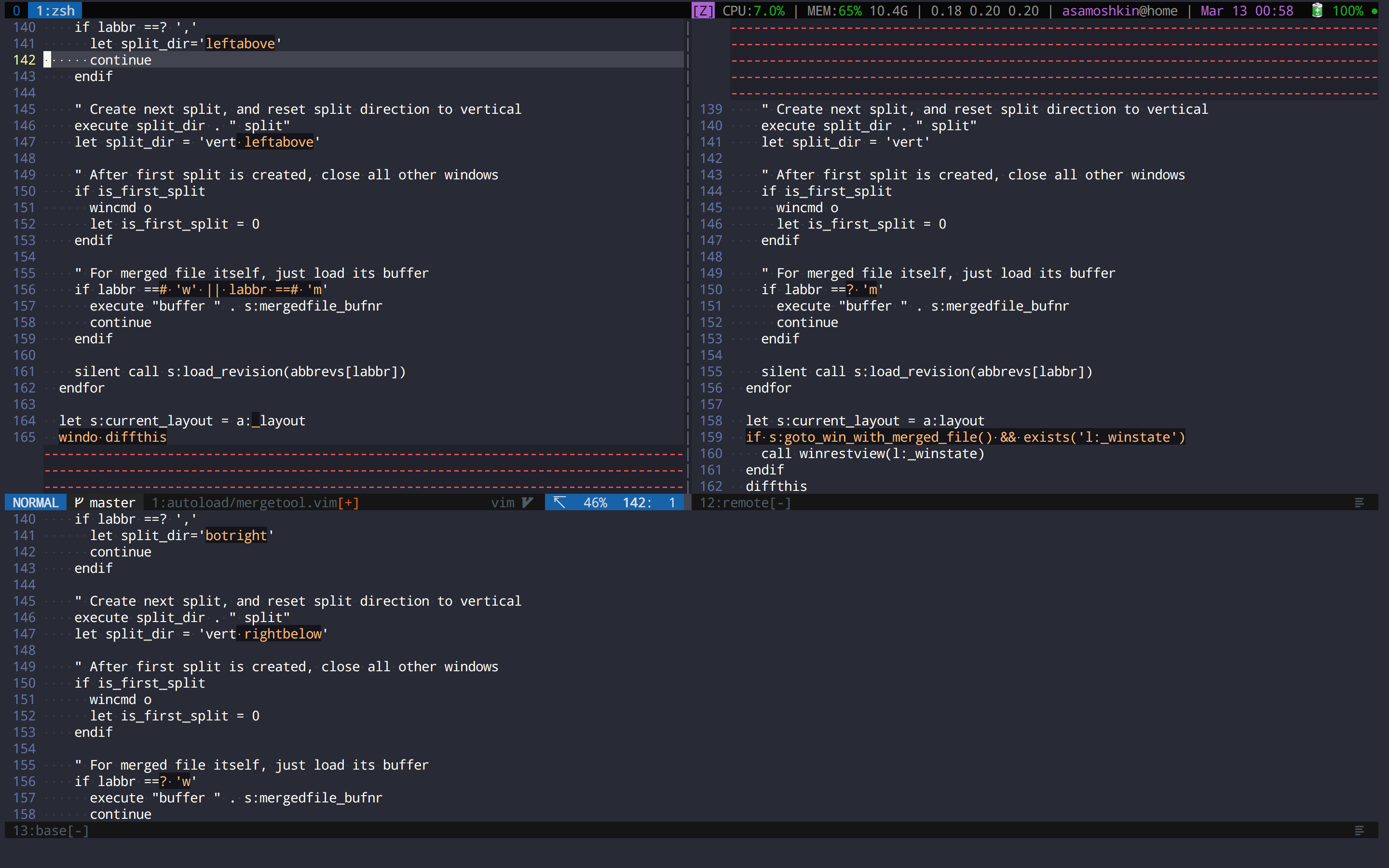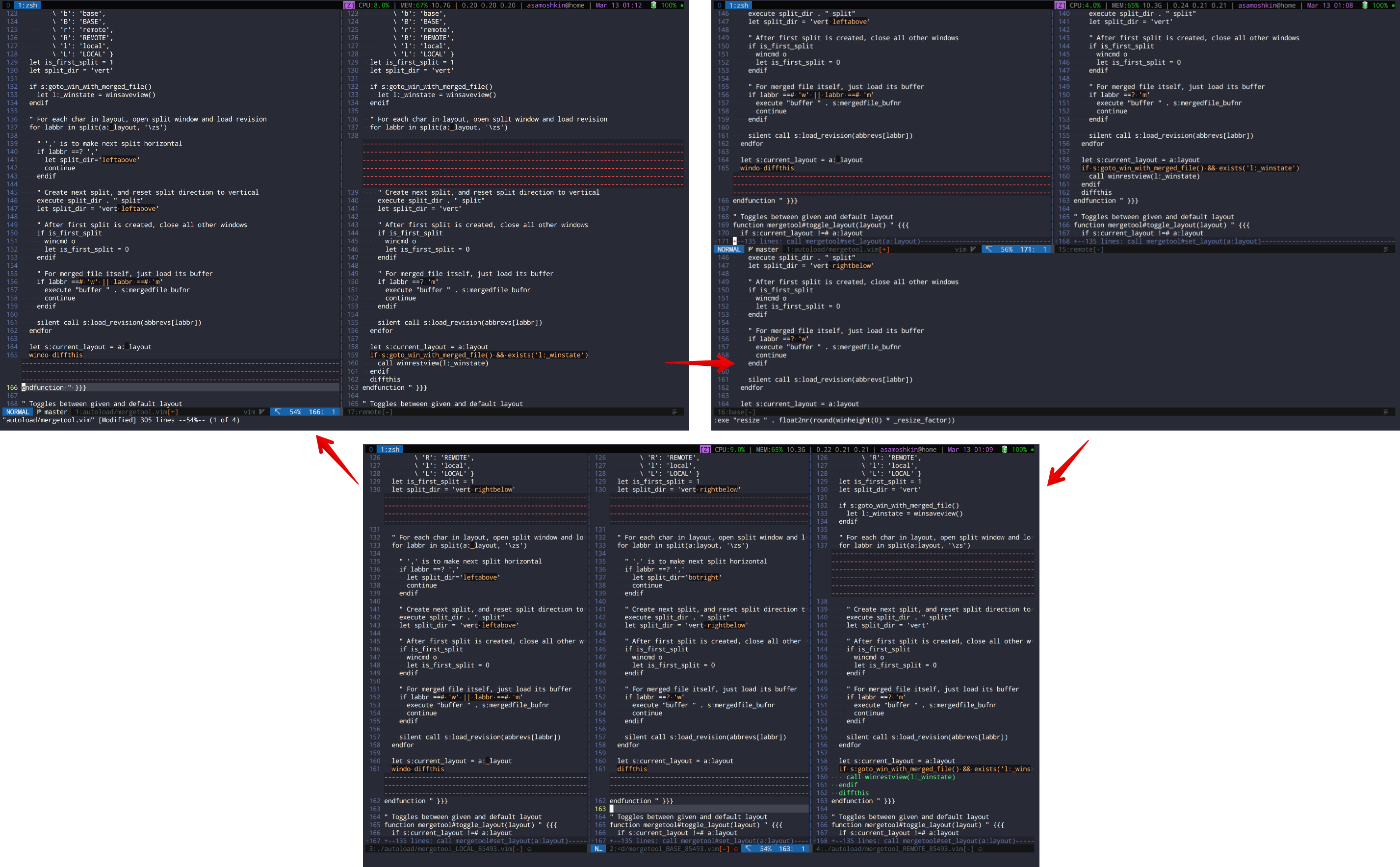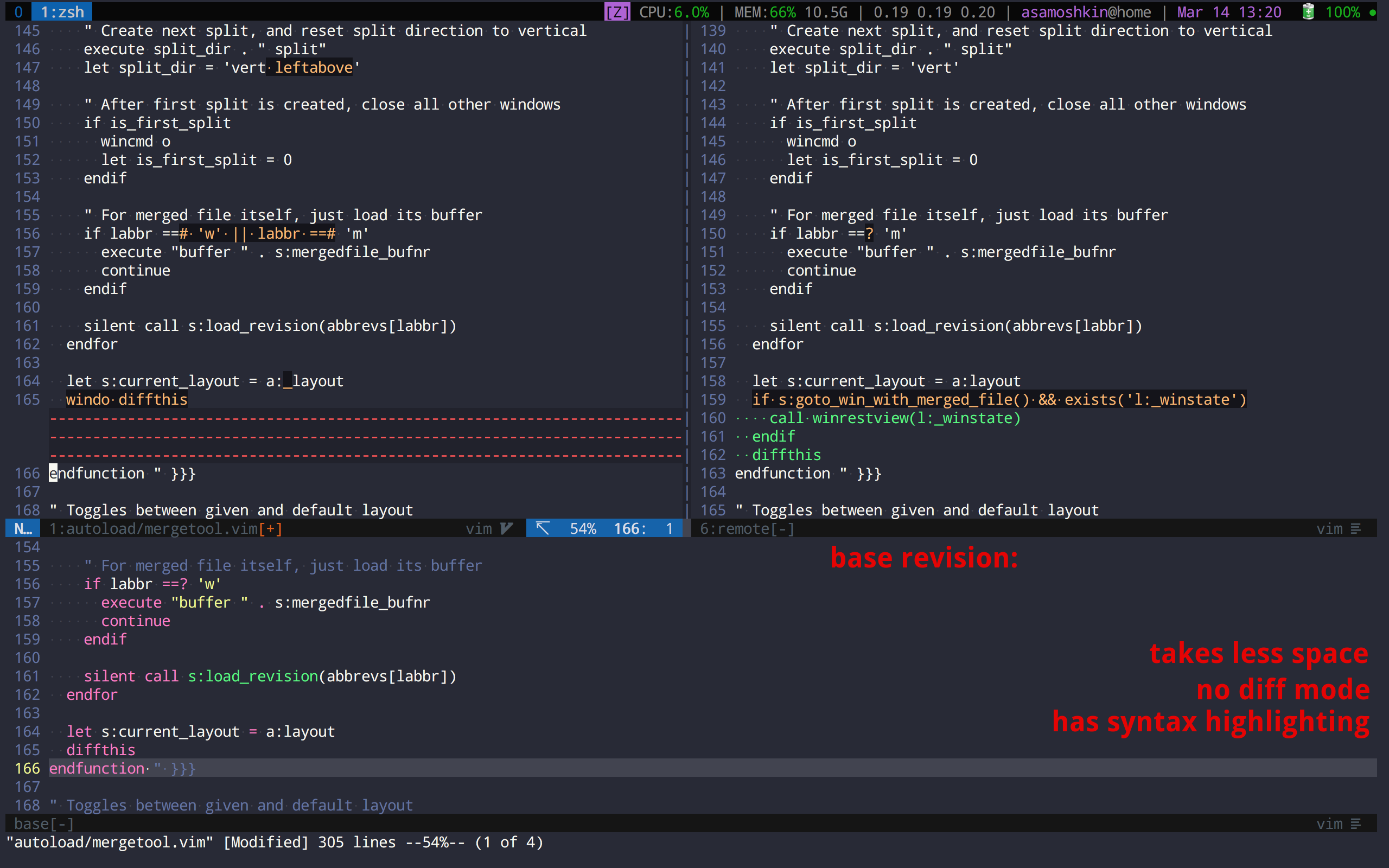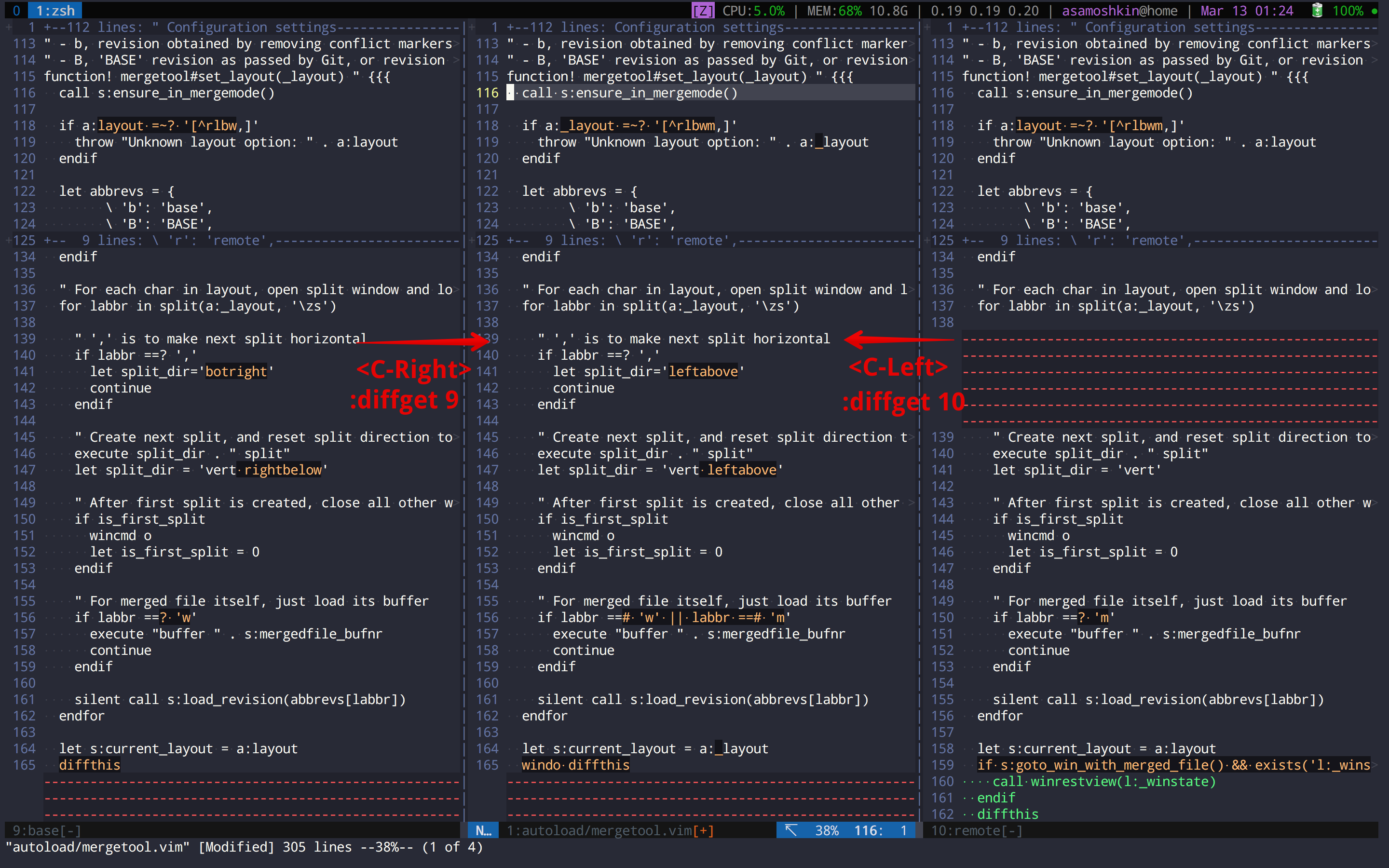samoshkin / Vim Mergetool
Labels
Projects that are alternatives of or similar to Vim Mergetool
vim-mergetool
Efficient way of using Vim as a Git mergetool. 🍰 With vim-mergetool you can have your cake and eat it too. Check out the demo.

Overview
vim-mergetool processes MERGED file and extracts ours, theirs, or common sides of a conflict by parsing conflict markers left by Git. Then it shows 2-way diff between ours and theirs versions, with raw conflict markers being already removed.
Unlike simply comparing between LOCAL and REMOTE history revisions, it takes over where automatic Git merge algorithm gives up. Diffs are present only where Git cannot automatically resolve conflicts, and you're not distracted with diff highlighting of already resolved hunks.
In a screenshot below, MERGED file is on the left with conflict markers already removed with optimistic assumption of picking up changes from ours side. Then it's compared to the REMOTE branch, but focusing only on conflicts. This solution highlights the actual merge conflicts instead of all the diffs.
Plus, to resolve the conflict you don't need to edit conflict markers directly - just pick either side of a conflict using :diffget and :diffput commands.
This plugin was initially inspired by whiteinge/diffconflicts. Check out how this plugin is different from existing solutions.
Minimal working example (TL;DR)
Use your favorite Vim plugin manager.
Minimal working configuration using vim-plug.
set nocompatible
filetype plugin indent on
call plug#begin('~/.vim/plugged')
Plug 'samoshkin/vim-mergetool'
call plug#end()
let g:mergetool_layout = 'mr'
let g:mergetool_prefer_revision = 'local'
In Vim, open a file with conflict markers, and start mergetool.
:MergetoolStart
vim-mergetool would show 2-way diff in a new tab with $MERGED file on the left. By default, all conflicts are already resolved by picking up ours/LOCAL version. You don't need to edit raw conflict markers manually. Either leave hunk as is, or pick theirs/REMOTE version with :diffget from the right, or edit hunk manually.
Once done, quit merge tool:
:MergetoolStop
There's a single :MergetoolToggle command can both start and stop merge mode. Plus, you can set up a key mapping to toggle merge mode:
nmap <leader>mt <plug>(MergetoolToggle)
This example only scratches the surface of what vim-mergetool can do. Keep reading, if you need more features/customization.
Conflict markers format
[ASSUMPTION]: vim-mergetool expects conflict markers in a MERGED file to include common base ancestor version as well. This is called diff3 conflict style.
" <<<<<<< HEAD
" ours/local revision
" ||||||| base
" common base revision
" =======
" theirs/remote revision
" >>>>>>> feature
If you get "Conflict markers miss common base revision" error message, put the following in your ~/.gitconfig to use diff3 conflict style as a default:
[merge]
conflictStyle = diff3
If something goes absolutely wrong, you can always reset conflict markers in a file to their initial state. It's safe to do it only during ongoing merge, otherwise you'd overwrite file in a working tree with version from index.
git checkout --conflict=diff3 {file}
Features
- Flexible layouts. You're not limited to default 2-way diff layout. You can use 3-way diff layout, or even setup window of 4 splits. Both horizontal and vertical splits are supported, and mix thereof.
- Toggle between layouts during merge. You can have several layouts and toggle between them during merge. For example, you're using 2-way diff by default, but sometimes you want to quickly recall what's the state of a diff in the
BASErevision, but don't want to keep 3rdBASEsplit constantly opened. - Customize layout splits as you like: resize, turn off syntax highlighting, turn off diff mode.
- Choose preferred conflict side.
oursside is picked up by default but you can also chooseours,theirsorbaseside of a conflict for theMERGEDfile, or work with raw conflict markers. - Conventional
LOCAL,REMOTE,BASEhistory revisions are available to compare to as well. - Can be run as a
git mergetool, or by opening a file with conflict markers from the running Vim instance. - Prompts whether merge was successful on quit. If not, rollbacks changes and report non-zero exit status code when run as a
git mergetool. - Smart diff exchange commands. Tell direction of a window to
diffgetordiffputinstead of specifying a buffer number. Especially handy for 3-way diffs. Not limited to merge conflict scenarios, can be used for regular diffs. - Can tell if we're in merge mode right now. Useful for showing some sort of indicator in a status line.
NOTE: vim-mergetool does not set up any key mappings for you. It justs exports a handful of commands and <plug> mappings. You're free to set up key mappings in your vimrc as you'd like.
Preferred conflict side
vim-mergetool removes conflict markers from MERGED file, and picks up ours/local side of a conflict by default. If you prefer another side of a conflict:
" possible values: 'local' (default), 'remote', 'base'
let g:mergetool_prefer_revision = 'remote'
If you don't want vim-mergetool to process MERGED file and remove raw conflict markers:
let g:mergetool_prefer_revision = 'unmodified'
Alternatively, you can start with local or unmodified revision, and change your mind later during merge process by running one of these commands:
:MergetoolPreferLocal
:MergetoolPreferRemote
Available revisions to compare
2-way diff between local and remote versions derived from conflict markers is a sane default, but you might want to compare MERGED file against other revisions:
-
LOCAL, current branch HEAD. -
REMOTE, HEAD of the branch we're going to merge -
BASE, common ancestor of two branches, i.e.git merge-base branchX branchY -
local,remote,base(in lowercase), those are revisions derived fromMERGEDfile by picking up either side of a conflict from conflict markers
Layout
vim-mergetool defaults to two vertical splits layout with MERGED file on the left, and remote revision on the right. MERGED file is processed according to g:mergetool_prefer_revision setting as described above.
" (m) - for working tree version of MERGED file
" (r) - for 'remote' revision
let g:mergetool_layout = 'mr'
If you want to use 3-way diff layout as a default, with a base revision in the leftmost split:
let g:mergetool_layout = 'bmr'
To show usual REMOTE, LOCAL, BASE history revisions, use uppercase characters:
let g:mergetool_layout = 'LmR'
By the way, this setup is pretty much same to what vim-fugitive :Gdiff does, except that conflict markers are already removed. You can use g:mergetool_prefer_revision='unmodified' to replicate vim-fugitive completely. Indeed, vim-mergetool is flexible enough to replicate any existing vim+merge solution.
Vertical splits are used by default. If you prefer working with horizontal splits:
let g:mergetool_layout = 'm,r'
You can mix both approaches. For example, show MERGED file and remote revision in vertical splits as usual, and have horizontal split with base revision at the bottom.
let g:mergetool_layout = 'mr,b'
Toggle layout during merge
You are not limited to single possible layout. You can switch easily between different layouts during merge process.
For example, you can start with 2-way diff layout, and then temporarily toggle additional split with base revision on the left or at the bottom. Or hide MERGED file altogether and review LOCAL, BASE and REMOTE history revisions.
" In 'vimrc'
" Default layout
let g:mergetool_layout = 'mr'
" Later, during merge process:
" View 'base' revision on the left
:MergetoolToggleLayout bmr
" View 'base' revision in horizontal split at the bottom
:MergetoolToggleLayout mr,b
" View history revisions, and hide 'MERGED' file altogether
:MergetoolToggleLayout LBR
In addition to commands, you can set up key mappings for your most common layouts:
nnoremap <silent> <leader>mb :call mergetool#toggle_layout('mr,b')<CR>
Advanced layout customization
If you want to further tweak layout or change settings of individual splits, define the callback function, which is called when layout is changed.
Example. When layout is mr,b, I want the base horizontal split to be pulled of a diff mode and have syntax highlighting enabled. Also, I want it to reduce its height.
function s:on_mergetool_set_layout(split)
if a:split["layout"] ==# 'mr,b' && a:split["split"] ==# 'b'
set nodiff
set syntax=on
resize 15
endif
endfunction
let g:MergetoolSetLayoutCallback = function('s:on_mergetool_set_layout')
Callback is called for each split in the layout, with a split being passed as a callback argument.
{
'layout': 'mb,r', # current layout
'split': 'b', # current split
'filetype': 'javascript', # file type of MERGED file
'bufnr': 2, # buffer number of current split
'winnr': 5 # window number of current split
}
Example. I want to turn off syntax and spell checking highlighting for all splits, so it doesn't distract me from diff highlighting.
function s:on_mergetool_set_layout(split)
set syntax=off
set nospell
endfunction
let g:MergetoolSetLayoutCallback = function('s:on_mergetool_set_layout')
Here's the end result:
Running as a git mergetool
vim-mergetool can be configured to run as a git mergetool. In your ~/.gitconfig:
[merge]
tool = vim_mergetool
conflictstyle = diff3
[mergetool "vim_mergetool"]
cmd = vim -f -c "MergetoolStart" "$MERGED" "$BASE" "$LOCAL" "$REMOTE"
trustExitCode = true
Git detects whether merge was successful or not in two ways:
- When
trustExitCode = false, checks ifMERGEDfile was modified. - When
trustExitCode = true, checks exit code of merge tool process.
vim-mergetool supports both options. On quit, if merge was unsuccessful, it both discards any unsaved changes to buffer without touching file's ctime and returns non-zero exit code.
Running directly from running Vim instance
You can enter and exit merge mode from running Vim instance by opening a file with conflict markers, and running one of the commands:
:MergetoolStart
:MergetoolStop
:MergetoolToggle
You can set up a key mapping to toggle merge mode:
nmap <leader>mt <plug>(MergetoolToggle)
When exiting merge mode, if merge was unsuccessful, vim-mergetool would discard changes to merged file and rollback to a buffer state as it were right before starting a new merge.
Unlike running as a git mergetool, LOCAL, REMOTE and BASE history revisions are not passed from the outside. In this mode, vim-mergetool extracts them from the numbered stages of Git index.
$ git cat-file -p :1:{file} > {file}.base
$ git cat-file -p :2:{file} > {file}.local
$ git cat-file -p :3:{file} > {file}.remote
ASSUMPTION: Therefore, it's assumed that a git merge is in progress, and cwd of running Vim instance is set to repository root dir.
Smart diff exchange commands
Vim's :diffget and :diffput commands are convenient and unambiguous as soon as you have only two buffers in diff mode. If you prefer 3-way diff, you're out of lucky, as you need to explicitly tell the buffer number you want to exchange diff with.
vim-mergetool comes with DiffExchange commands and mapping, that accepts direction of a diff movement: "left", "right", "up", "down". You can set up your own key mappings for diff mode only:
nmap <expr> <C-Left> &diff? '<Plug>(MergetoolDiffExchangeLeft)' : '<C-Left>'
nmap <expr> <C-Right> &diff? '<Plug>(MergetoolDiffExchangeRight)' : '<C-Right>'
nmap <expr> <C-Down> &diff? '<Plug>(MergetoolDiffExchangeDown)' : '<C-Down>'
nmap <expr> <C-Up> &diff? '<Plug>(MergetoolDiffExchangeUp)' : '<C-Up>'
Commands are available as well:
:MergetoolDiffExchangeLeft
:MergetoolDiffExchangeRight
:MergetoolDiffExchangeDown
:MergetoolDiffExchangeUp
DiffExchange logic runs either :diffget or :diffput with a right buffer number of adjacent window, depending on:
- given direction
- whether window in opposite direction exists or not
It's easier to explain with example.
Suppose, you have 3 split layout: MERGED file in the middle, base and remote revisions are on the sides. Typically, the middle one with a MERGED file is an active split. You navigate from hunk to hunk, and decide what to do with a conflict: leave as is, or pick version from left/right splits.
-
<C-Left>woulddiffgetchange from the right split into the middle one. If you imagine the diff movement - it goes from right to the left. -
<C-Right>woulddiffgetchange from the left split into the middle one. If you imagine the diff movement - it goes from left to the right.
If the rightmost split were the active one:
-
<C-Left>woulddiffputchange from the current split into the middle one. As soon as there is no adjacent window on the right to get change from, we invertdiffgetoperation intodiffput. -
<C-Right>woulddiffgetchange from middle split.
Same logic applies to "up" and "down" directions. Useful if you prefer horizontal splits.
Conclusion: despite how many splits are opened and what's the layout, you don't need to wrap your head around diffput vs diffget semantics, and you don't need to figure out correct buffer numbers manually. You just tell desired diff movement direction, and vim-mergetool handles the details for you.
Limitation: DiffExchange commands work only in normal mode, and do not support visual mode and working with line ranges.
DiffExchange functionality is not specific to resolving merge conflicts, and can be used for regular diffs.
If you like <C-arrow> mappings from the snippet above, you might also want to map <up> and <down> keys to navigate diffs, instead of default [c and ]c mappings. They're not used anyway, since you're using h,j,k,l for movements, are you? ;-)
nmap <expr> <Up> &diff ? '[c' : '<Up>'
nmap <expr> <Down> &diff ? ']c' : '<Down>'
Merge mode detection
You can detect whether you're in merge mode now, by inspecting g:mergetool_in_merge_mode variable.
It can be helpful to show indicator in a status line. Example for vim-airline:
function! AirlineDiffmergePart()
if get(g:, 'mergetool_in_merge_mode', 0)
return '↸'
endif
if &diff
return '↹'
endif
return ''
endfunction
call airline#parts#define_function('_diffmerge', 'AirlineDiffmergePart')
call airline#parts#define_accent('_diffmerge', 'bold')
let g:airline_section_z = airline#section#create(['_diffmerge', ...other_parts])
Quitting merge mode
When exiting merge mode, vim-mergetool would prompt you whether merge was successful. If not, it will rollback changes to the buffer, will not save MERGED file to disk, and exit with non-zero code, when running as a git mergetool.
You can either issue :MergetoolStop or :MergetoolToggle commands, or use dedicated mapping.
Yet another approach, which I prefer in my personal vimrc, is having a <leader>q key mapped to context-aware QuitWindow() function. It detects whether we're in merge mode, and runs :MergetoolStop command, or just uses normal "quit" command otherwise.
function s:QuitWindow()
" If we're in merge mode, exit
if get(g:, 'mergetool_in_merge_mode', 0)
call mergetool#stop()
return
endif
if &diff
" Quit diff mode intelligently...
endif
quit
endfunction
command QuitWindow call s:QuitWindow()
nnoremap <silent> <leader>q :QuitWindow<CR>
How is it different from X?
Most merge tools use 3-way diff approach by showing several split windows, that include LOCAL revision (current branch), REMOTE revision (branch we're going to merge), BASE revision (common base ancestor), and working tree version of MERGED file with or without conflict markers.
Here is the same merge scenario opened with a default vimdiff as a mergetool:
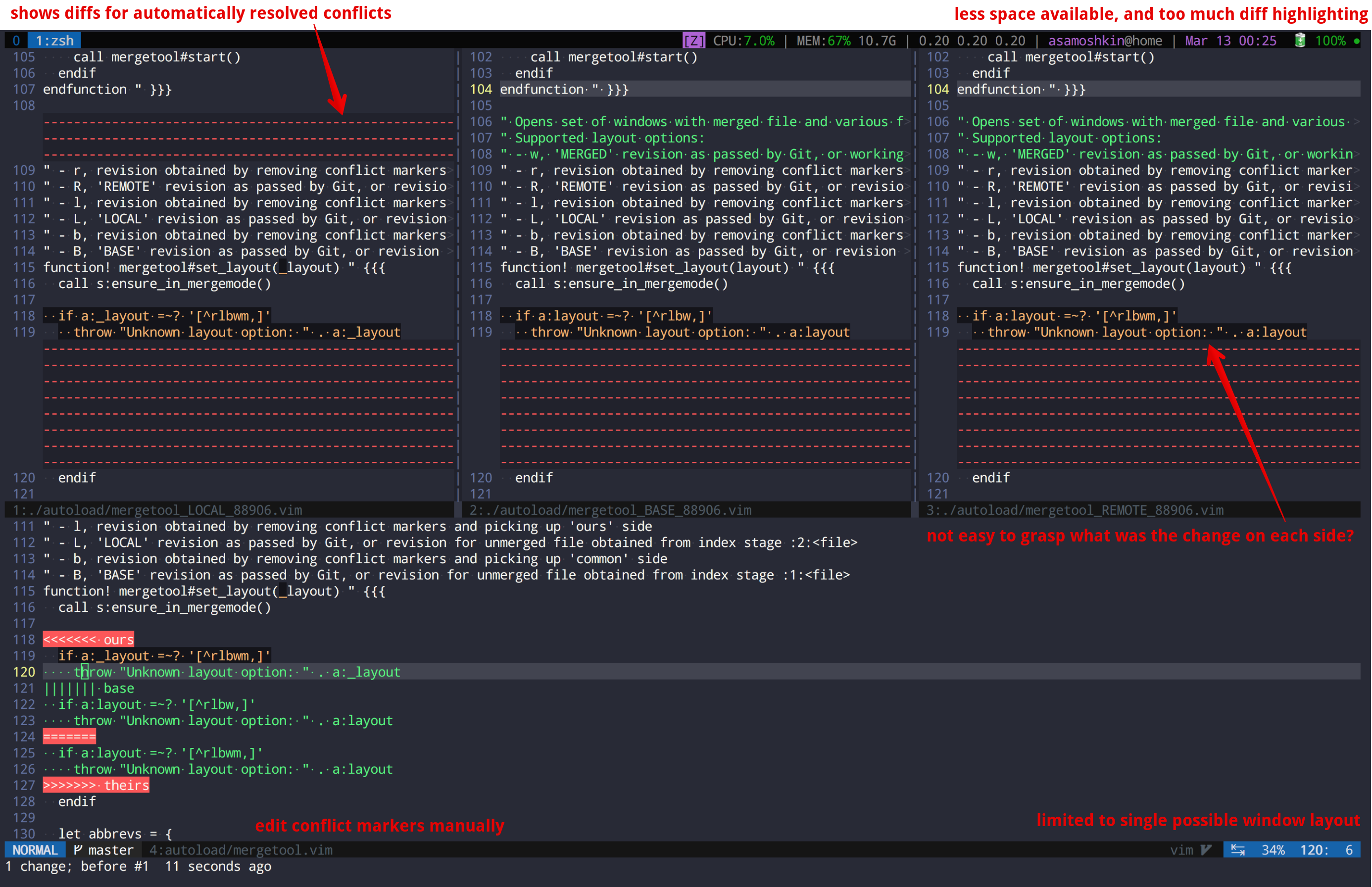
While 3-way diff paradigm is superior to 2-way diff for merging purposes, it does not fit Vim well:
Disadvantages:
- When several revisions are compared at the same time (i.e.
:diffthisin all buffers), Vim highlights every diff between each of those files. Usually that means every possible change between BASE-LOCAL-REMOTE-MERGED files, including those which are not relevant to conflict resolution. - It highlights even those hunks, which were already automatically resolved by
git merge-file. It distracts you from focusing purely on unresolved conflicts. Indeed, I don't want to care about already resolved conflicts. - Limited window width when three vertical splits are opened. Forces you to scroll horizontally, or wrap lines. Unless you have enough screen width, it's difficult to quickly grasp changes when window width is only ~50 columns or so. Usually, it's not easy to tweak predefined layout.
- Forces you to pick up conflict side by directly editing conflict markers, instead of choosing change from the left or the right.
-
:diffgetand:diffputVim commands are convenient only when there're two split windows, otherwise they become ambiguous and you need to tell them the target buffer number, which is a real showstopper. No one wants to think on "What's the Vim's buffer number of the window on the right/left?", when you're already pulling your hair trying to resolve conflicts from long-running "feature" branch.
Existing solutions
- default
vimdiffmerge tool. Shows layout with 3 vertical splits:LOCAL,REMOTE,BASErevisions, and the horizontal split at the bottom with aMERGEDfile, containing raw conflict markers. -
vim-fugitive
:Gdiffcommand, which automatically detects conflict markers in a file and switches into 3-way diff. Shows 3 vertical splits:LOCAL,REMOTErevisions andMERGEDfile in the middle with raw conflict markers. See this reddit comment on difference between vim-fugitive and this plugin. -
whiteinge/diffconflicts. Parses
MERGEDfile and removes conflict markers to pick up one side of a conflict. Default to 2-split layout withlocalandremoterevisions.vim-mergetooluses the same idea, plus brings many additional features. - sjl/splice.vim. Haven't yet had experience with it.
- Drop using Vim as a mergetool. Use some GUI program, like DiffMerge or Kdiff3. Better to use both Vim and some GUI tool as a backup though.

